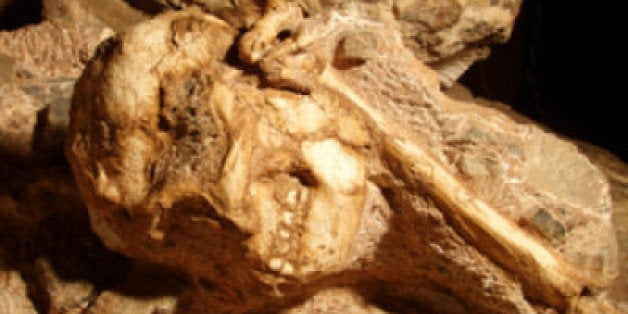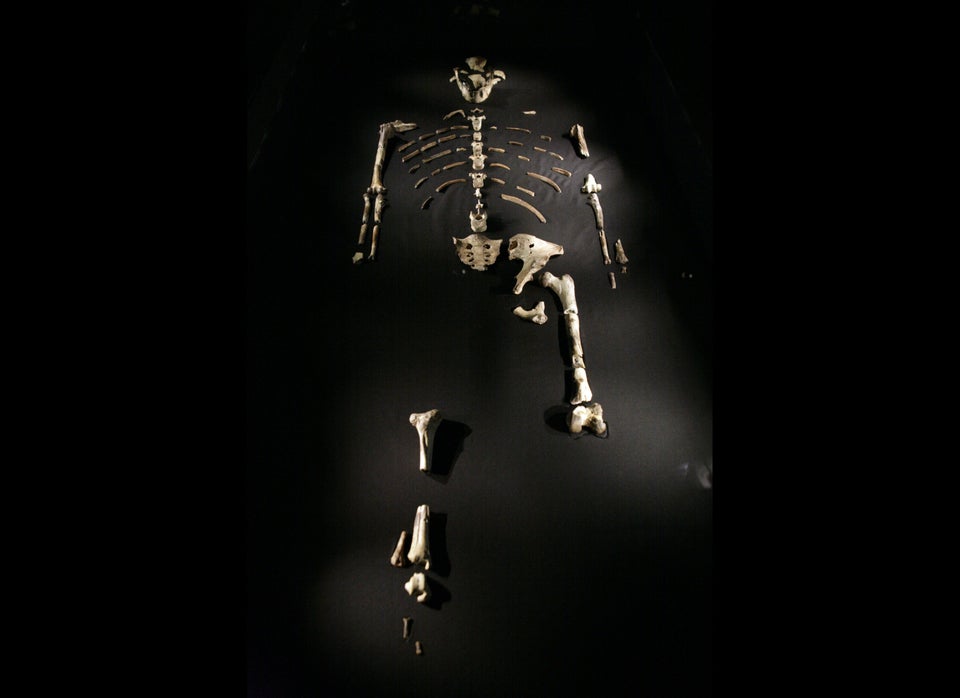
PARIS—He may be called Little Foot, but for human evolution researchers he’s a big deal: His is the most complete skeleton known of an early member of the human lineage. Ever since the skeleton was discovered in a South African cave in the 1990s and named for its relatively small foot bones, researchers have been fiercely debating how old it is, with estimates ranging from about 2 million years to more than 3 million. A new geological study of the cave concludes that Little Foot is at least 3 million years old. If correct, that would mean he is old enough to be a direct ancestor of today’s humans, and could shift South Africa to the forefront of human evolution.
The first traces of the skeleton were found in the early 1990s by Ron Clarke, a paleoanthropologist at the University of the Witwatersrand in Johannesburg, South Africa. He was rummaging through boxes of animal bones previously excavated in the Sterkfontein caves, about 40 kilometers northwest of Johannesburg, where a number of fossils of australopithecines—advanced apes similar to the famous Lucy—have been discovered. Clarke found four small australopithecine foot bones, and set off with his team to unearth the skeleton that they came from.
In 1997, they found it, deeply embedded in rock that had formed after Little Foot apparently fell 20 meters into the cave through a hole in the ground above. Virtually the entire skeleton was preserved down to the smallest finger and toe bones, an extremely rare event. (Lucy, for example, is only about 40% complete.) It took more than 15 years to excavate the fragile fossils from the rock.
Several teams tried to determine the age of the skeleton by dating the rocks around it, using techniques based either on the earth’s magnetic field or the decay of uranium in the rocks. (The bones are far too old for radiocarbon dating, which cannot peer back further than about 45,000 years.) Clarke’s team estimated Little Foot to be about 3.3 million years old—about as old as Lucy, found in East Africa. And although its anatomical details have yet to be published in detail, Clarke says Little Foot appears to be somewhat closer to later humans than Lucy: While its skull is primitive like Lucy’s, its hands are more modern, and its feet have both apelike and human features.
But the dating has remained controversial. Three other teams have come up with later dates of about 2.2 million to 2.6 million years, although they all considered the younger dates to be more likely. If the fossils are indeed younger or about the same age as the first members of Homo, which date about 2.5 million years ago, they cannot be ancestral to it.
The dating discrepancies were largely due to a difference of opinion about how soon the rocks around the bones were formed after Little Foot fell into the cave: Clarke insisted that a great deal of time had passed, while the other researchers concluded that they had probably been laid down relatively soon after the poor australopithecine’s fatal accident. So Clarke teamed up with geomorphologist Laurent Bruxelles of the University of Toulouse in France to undertake what they claim is the most detailed study yet of how the rocks in the cave, along with its stalactites and stalagmites, were formed. The conclusions, in press at the Journal of Human Evolution, were announced today at simultaneous press conferences in Paris and Johannesburg, led by Bruxelles and Clarke, respectively.
The team, using a combination of microscopic and geochemical techniques, concluded that after Little Foot fell into the cave, spaces began to appear between the skeleton and the rock that first formed around it. Over a period of at least 1 million years, these spaces were filled by repeated flows of minerals carried by water flowing through the cave, similar to the way that stalactites and stalagmites are formed by the dripping of water. So while other teams may have been correct in dating these so-called flowstones to as late as 2.2 million years old, the skeleton itself is much older, Bruxelles and Clarke argue. They were not able to come up with an exact age, but estimate that Little Foot died at least 3 million years ago, based on dates previously obtained for other parts of the cave near where the skeleton was found.
At the Paris press conference, Bruxelles pointed out that many researchers had earlier discounted the possibility that Little Foot was a candidate as an ancestor of Homo because of the late date. Thus, many scientists had focused their search for human origins on East Africa, especially Ethiopia, where Lucy was found, and Kenya. But the new dating puts South Africa back in the running as the original home of the Homo line, Bruxelles said.
Paul Renne, a dating expert at the Berkeley Geochronology Center in California, says that this kind of detailed study of the cave’s geology “has been long overdue.” Renne adds that no matter how precise the dating of the flowstones surrounding Little Foot, “without accurate geologic context they are useless. Actually, they are worse than useless because incorrect conclusions may be drawn from them, as seems to have been the case” with the younger proposed dates for the skeleton.
But Andy Herries, a dating expert at La Trobe University near Melbourne, Australia, who led one of the teams that came up with younger dates based on magnetic analyses of the flowstones, says that nothing in the paper contradicts his team’s estimate that all of the rocks surrounding the skeleton were laid down between 2.6 million and 2.2 million years ago. And as for the 3-million-year date for the skeleton itself, Herries says it was “plucked out of thin air.” We still don’t know exactly how old Little Foot is, Herries insists, a point which Bruxelles and Clarke themselves concede.
Original article:
This story has been provided by AAAS, the non-profit science society, and its international journal, Science.
